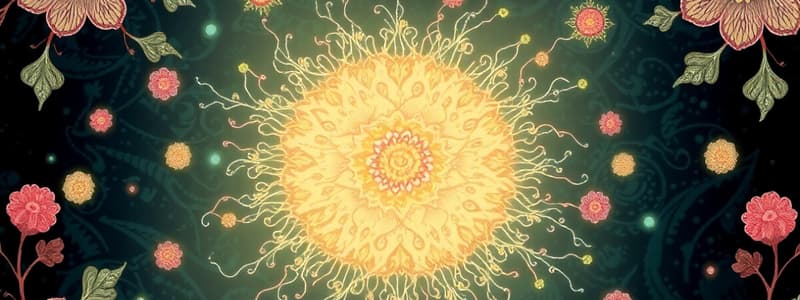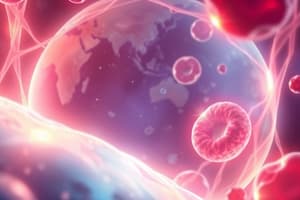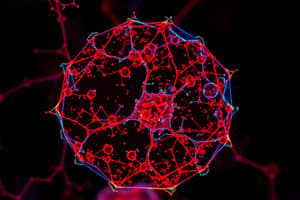Podcast
Questions and Answers
What initial observation led to the discovery of stem cells?
What initial observation led to the discovery of stem cells?
- Clones of cells forming colonies in the bone marrow of mice.
- Radiation-induced chromosomal changes in mice.
- Unexpected bone growth in mice.
- Small bumps on the spleens of mice after autopsies. (correct)
How did Till and McCulloch determine that spleen nodules originated from single cells?
How did Till and McCulloch determine that spleen nodules originated from single cells?
- By counting the number of nodules on each spleen.
- By using radiation-induced chromosomal markers to trace cell lineages. (correct)
- By observing the varied functions of cells within each colony.
- By measuring the radiation sensitivity of the donor cells.
What was the key discovery made by McCulloch and Till in 1961 concerning stem cells?
What was the key discovery made by McCulloch and Till in 1961 concerning stem cells?
- That stem cells are sensitive to radiation and can be damaged.
- That special bone marrow cells could self-renew and multiply. (correct)
- That the number of spleen bumps is proportional to marrow cells received.
- That stem cells reside primarily in the spleen of the organism.
What was the primary purpose of Till and McCulloch's research involving irradiating mice?
What was the primary purpose of Till and McCulloch's research involving irradiating mice?
What is the significance of the term "colony-forming units"?
What is the significance of the term "colony-forming units"?
How did Yamanaka's research contribute to the understanding of stem cells?
How did Yamanaka's research contribute to the understanding of stem cells?
What is the meaning of "pluripotent" in the context of stem cell research?
What is the meaning of "pluripotent" in the context of stem cell research?
What delayed the publication of Till and McCulloch's findings?
What delayed the publication of Till and McCulloch's findings?
What observation linked the number of spleen nodules to bone marrow cells?
What observation linked the number of spleen nodules to bone marrow cells?
What was the key characteristic of cells found within spleen colonies that supported the existence of stem cells?
What was the key characteristic of cells found within spleen colonies that supported the existence of stem cells?
Flashcards
Stem Cells
Stem Cells
Unique cells that can self-renew and turn into specialized cell types.
McCulloch and Till's Discovery
McCulloch and Till's Discovery
They discovered the first evidence of stem cells in 1961.
Colony-Forming Units
Colony-Forming Units
Cells that form nodules growing from a single precursor cell.
Irradiation Experiment
Irradiation Experiment
Signup and view all the flashcards
Pluripotent Stem Cells
Pluripotent Stem Cells
Signup and view all the flashcards
Induced Pluripotent Stem Cells (iPS)
Induced Pluripotent Stem Cells (iPS)
Signup and view all the flashcards
Yamanaka's Contribution
Yamanaka's Contribution
Signup and view all the flashcards
Serendipity in Research
Serendipity in Research
Signup and view all the flashcards
Bone Marrow Transplants
Bone Marrow Transplants
Signup and view all the flashcards
Effects of Nuclear Radiation
Effects of Nuclear Radiation
Signup and view all the flashcards
Study Notes
McCulloch and Till's Discovery
- McCulloch and Till combined cellular biology and biophysics skills to discover the first clue to stem cells in 1961.
- Their research on bone marrow cells revealed a special type of cell capable of becoming other specialized cells.
- Stem cells can self-renew and multiply.
Unexpected Findings
- The discovery was accidental; McCulloch observed bumps (nodules) on mice spleens that directly correlated to the number of live marrow cells.
- This prompted further research using radiation to study these cells' development.
Colonies of Clones
- Till and McCulloch worked with a PhD student to determine whether nodules originated from one or many cells.
- They used radiation to mark chromosomes in donor cells.
- Cells with altered chromosomes formed clones—each nodule containing a single, original cell.
- These cells were termed colony-forming units (CFU).
Bone Marrow Transplantation Research
- Their experiments involved irradiating mice to destroy existing bone marrow cells, then transplanting donor marrow cells.
- Different radiation doses were used to monitor surviving donor cells.
- Marrow transplants were tracked over 10 days using autopsies.
- Data showed a direct relationship between donor cells and the number of spleen nodules.
Stem Cell Significance
- The discovery revealed bone marrow contains special cells capable of reproduction and development into various cell types.
- Their discovery advanced biological science, as this process is how the body heals and regenerates damaged tissue.
- This knowledge has huge potential for treating disease.
- Stem cells exist in all stages of life and development.
Studying That Suits You
Use AI to generate personalized quizzes and flashcards to suit your learning preferences.





